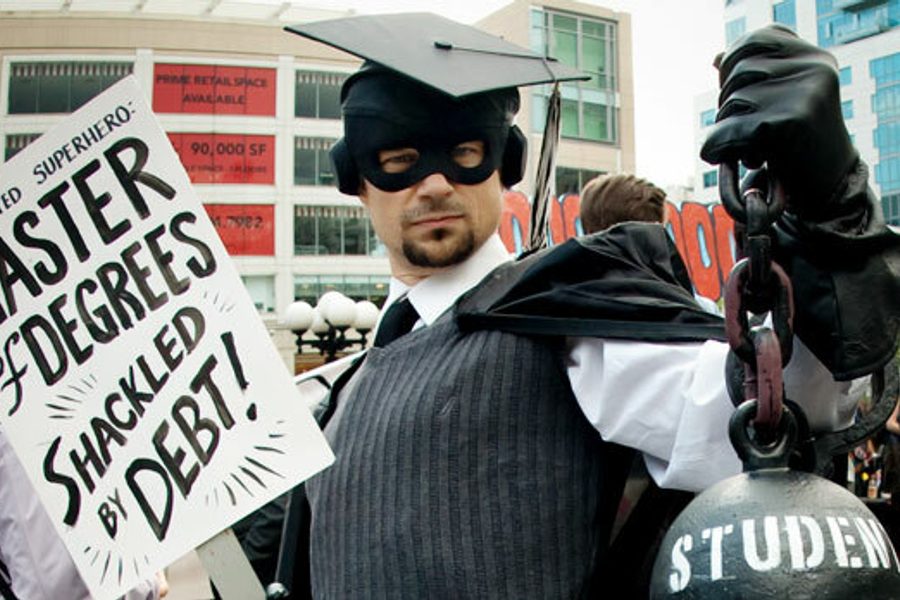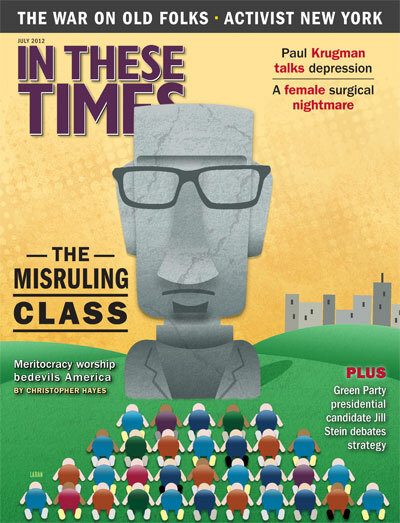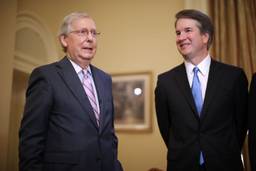
Editor’s Note: In a February 2006 In These Times cover story titled “In the Search of Solidarity,” Christopher Hayes, then a senior editor for the magazine, wrote:
Right now, our politics are atomized and transactional: we send checks, we sign petitions, we forward articles. We buy sweat-free clothes, recycle and look for vocations that don’t collude too egregiously with evil. But we’ve unconsciously circumscribed the boundaries of political action. … As the American Right offers that redundant canard “moral values” as its lodestar, the Left should offer solidarity. Not retrograde brotherhood, or faith-specific fellowship, but something more robust and difficult and rewarding. The uplift of collective enterprise.”
In his just published book Twilight of the Elites: America After Meritocracy (Crown), from which this essay is adapted, Hayes calls for citizens to stand in solidarity against the misrule of members of America’s reigning meritocracy.
We now operate in a world in which we can assume neither competence nor good faith from the authorities. The consequences of this simple, devastating realization define American life. The failure of the elites and the distrust it has spawned is the most powerful and least understood aspect of current politics and society. It structures and constrains the very process by which we gather facts, form opinions, and execute self-governance. It connects the Iraq War and the financial crisis, the Tea Party and MoveOn, the despair of laid-off autoworkers in Detroit to the foreclosed homeowners in Las Vegas and the residents of the Lower Ninth Ward in New Orleans: nothing seems to work. All the smart people fucked up, and no one seems willing to take responsibility.
The key both to Barack Obama’s political success and to his political setbacks lies in his ability to connect to our core sense of betrayal and his inability to deliver us from elite failure.
Obama only had a fighting chance at the Democratic nomination because of the credibility bestowed by his appearance at a 2002 Chicago rally opposing the invasion of Iraq, where he referred to the impending invasion as a “dumb war.” He, alone among the leading contenders, was able to see that the emperor had no clothes. He invoked, time and time again, the great social movements in American history that attacked the authority of the unjust institutions that preserved the status quo. And he advanced a critique of American politics at the end of the Bush years that homed in on the fundamental dysfunctions, improper dependencies, and imbalances of power that had led to the mess we were in.
But as much as Obama spoke to the desire of Americans for reconstruction, and reform, he also cultivated the support of those members of the elite who had grown disgusted with and weary of the Bush administration, and who longed for restoration of authority rather than a revolution from below. Barack Obama may have constantly invoked his years as a community organizer in Chicago, but he spent just as much time at Harvard Law.
In his very first speech as president, Obama avoided castigating the establishment and instead urged Americans to trust in it once again. He acknowledged that there was a “sapping of confidence across our land; a nagging fear that America’s decline is inevitable, that the next generation must lower its sights.” But rather than use the speech to explain just how and why our confidence was sapped, he instead announced that sheer will and determination would be the key to repairing our broken trust: “Starting today, we must pick ourselves up, dust ourselves off, and begin again the work of remaking America.”
In 2008, trust in a number of institutions, most notably the presidency, shot up, born on a wave of optimism ushered in by the beginning of the Obama era. For a year, trust in the president as an institution was above 50 percent. But by 2010 it had plummeted back down toward Bush levels in the aftermath of Hurricane Katrina.
Part of the reason for that decline was that despite his campaign promises to take on the “system,” the president has operated safely within it.
Corrupt and dysfunctional
Three decades of accelerating inequality in America have produced a deformed social order and a set of elites who cannot help but be dysfunctional and corrupt. Most of us don’t see it that way, because we get elites wrong.
We don’t acknowledge that our own most fundamental, shared beliefs about how society should operate are deeply elitist. We have accepted that there will be some class of people that will make the decisions for us, and if we just manage to find the right ones, then all will go smoothly.
To recover from the damage inflicted by this crisis of authority, we must reconstruct and reinvent our politics, a process that has, in a sense, already begun. Andrew Smith, an organizer with Occupy Wall Street, told me one fall evening in 2011 that the movement is not “Left or Right, but up or down.” Amid drums and whoops and chants of “We! Are! The 99 percent!” he leaned in and said, “I realize that’s scary for some people.”
Beyond Left and Right isn’t just a motto. To those clued in to elite failure, Left/Right distinctions are less salient than those between what I call insurrectionists and institutionalists.
Paul Krugman is one prominent example of an insurrectionist. A man who was once a defender of elite competence and neoliberal technocracy against its populist foes, he has come to believe there is something very wrong with the people running the country.
The experience of the fail decade has made Krugman profoundly skeptical of elite opinion and what he derisively calls Very Serious People. He now approvingly cites such insurrectionist heroes as Naomi Klein, author of The Shock Doctrine, something that would have been unthinkable a decade before.
On the other side are the institutionalists, who see the erosion of authority and declining public trust as a terrifying trend. Like Edmund Burke, the institutionalists look on aghast as pillar institutions are attacked as decadent and dissolute by the uninformed rabble.
Institutionalists live in fear of a society without central repositories of authority, one that could collapse into mob rule at any time. The New York Times columnist David Brooks is institutionalism’s most accessible advocate and in 2009 he laid out its vision. Citing the political scientist Hugh Heclo, who wrote the book On Thinking Institutionally, Brooks writes that “the institutionalist has a deep reverence for those who came before and built up the rules that he has temporarily taken delivery of … . Lack of institutional awareness has bred cynicism and undermined habits of behavior.”
Which side are you on?
What divides the institutionalist from the insurrectionist is a disagreement over whether the greatest threat we face is distrust — a dark and nihilistic tendency that will produce a society bankrupted of norms and order — or whether the greater threat is the actual malfeasance and corruption of the pillar institutions themselves. (While my own insurrectionist sympathies are considerable, I am also stalked by the fear that the status quo, in which discredited elites and institutions retain their power, can just as easily produce destructive and antisocial impulses as it can spur transformation and reform. Call it my inner David Brooks. When people come to view all formal authority as fraudulent, good governance becomes impossible, and a vicious cycle of official misconduct and low expectations kicks in.)
Whether you align yourself with the institutionalist or the insurrectionist side of the debate comes down to just how rotten you think our current pillar institutions and ruling class are. Can they be gently reformed at the margins or must they be radically overhauled, perhaps even destroyed and rebuilt?
Barack Obama seemed to suggest he was on the side of those who favored radical overhaul, but he has governed as a man who believes in reform at the margins. And how could he do anything but? He is, after all, a product of the very institutions that are now in such manifest crisis. The central tragic irony of the presidency of Barack Obama is that his election marked the crowning achievement of the post-1960s meritocracy, just at the moment that the system was imploding on itself.
Like all ruling orders, the meritocracy tends to cultivate within its most privileged members an abiding devotion. Recruitment into the top ranks of the meritocracy also cultivates a disposition to trust one’s fellow meritocrats and to listen closely to those who occupy the inner circle of winners. “Obama’s faith lay in cream rising to the top,” writes Jonathan Alter in his chronicle of Obama’s first year, The Promise. “Because he himself was a product of the great American postwar meritocracy, he could never fully escape seeing the world from the status ladder he had ascended.”
Meritocracy’s good intentions
The last crisis of authority, the iconic, long period of social upheaval we refer to as “the sixties,” also represented what would be the high point for economic equality in the country. Labor unions were strong, wages steadily rising, and basic components of middle-class life — healthcare, housing and higher education — accessible to more house-holds than ever in the nation’s history.
But the country was also grossly unequal along lines of race, gender and sexual orientation, and controlled by a relatively small, self-contained set of white Anglo-Saxon men. By waging a sustained assault on the establishment responsible for perpetuating the Vietnam War, patriarchy and racial discrimination, the social movements of that era permanently transformed American society for the better.
In place of the old WASP establishment, America embraced meritocracy, an ideal with roots that reach back to the early years of the Republic. By opening the doors to women and racial minorities, while also valuing youth over seniority and individual talent over the quiet virtues of the Organization Man, it incorporated the demands of the social movements of the 1960s. But whatever the egalitarian commitments of the social movements that brought about the upheaval of the time, what emerged when the dust had settled was a model of the social order that was more open but still deeply unequal.
The meritocracy offered liberation from the unjust hierarchies of race, gender and sexual orientation, but swapped in their place a new hierarchy based on the notion that people are deeply unequal in ability and drive. It offers a model of society that confers vastly unequal compensation and resources on the bright and the slow, the industrious and the slothful. At its most extreme, this ethos celebrates an “aristocracy of talent,” a vision of who should rule that is in deep tension with our democratic commitments. “Meritocracy,” as the late historian Christopher Lasch once observed, “is a parody of democracy.”
Over the last 30 years our commitment to this parody of democracy has facilitated accelerating and extreme economic inequality of a scope and scale unseen since the last Gilded Age. There are numerous reasons for the explosion of inequality — from globalization, to technology, to the corruption of the campaign finance system, to the successful war on organized labor — but the philosophical underpinning for all of this, the fertile soil in which it is rooted, is our shared meritocratic commitment. Fundamentally we still think that a select few should rule; we’ve just changed our criteria for what makes someone qualified to be a member in good standing of that select few.
At its most basic, the logic of “meritocracy” is ironclad: putting the most qualified, best-equipped people into the positions of greatest responsibility and import. You certainly wouldn’t want surgeons’ licenses to be handed out via lottery, or to have major cabinet members selected through reality TV – style voting.
But in our near-religious fidelity to the meritocratic model, we overestimate its advantages and underappreciate its costs, because we don’t think hard enough about the consequences of the inequality it produces. As Americans, we take it as a given that unequal levels of achievement are natural, even desirable. Sociologist Jerome Karabel, whose work looks at elite formation, once said no advanced democracy was “as obsessed with equality of opportunity or as relatively unconcerned with equality of condition” as the United States.
This is our central problem. And the solution for correcting the excesses of our extreme version of meritocracy is quite simple: Make America more equal.
Vision for change
Any vision of egalitarian policies isn’t worth much without a vision for how to create the political space for their adoption.
The first set of obstacles has to do with public opinion, or, at least, perceptions of public opinion. It is a widely held view that America’s less egalitarian social structure is a manifestation of a certain kind of American exceptionalism. But in poll after poll, when asked how they want to reduce the deficit, Americans reliably choose cutting military spending and raising taxes on the wealthy as their two most favored approaches.
So the obstacle to more equality is not widespread public opposition to a more egalitarian society. The obstacle is simply that people and institutions who benefit most from extreme inequality have outsize power they can use to protect their gains from egalitarian incursions. The most pressing challenge for those who desire a better functioning, more representative nation is conceiving not of policies that will ultimately enhance equality, but of mechanisms by which the power of the current elite might be challenged and dramatically reduced.
Because the meritocratic winners are reluctant to part with their power, they must be convinced that the current status quo is unsustainable. Normalcy is what keeps the system moving and its inequities unaddressed — so normalcy must be disrupted. The social distance between the current beneficiaries of our post-meritocratic social order and its victims must be annihilated.
Occupy Wall Street succeeded in troubling the waters. By occupying public spaces in cities and towns across the country, the protesters disrupted the basic normalcy of everyday life. Mayors and police and media and fellow citizens had to, if nothing else, pay attention. And while the message may have been polarizing or sometimes lost between the various incidents of police violence and bullying, the basic effort was successful in dramatically expanding public consciousness of the basic problem of inequality and the rigged game it had created.
But disruption as disruption isn’t enough. In order to actually effect deep and lasting change, those opposed to the current social order must locate another base of power that can credibly challenge the power of incumbent interests.
I think the answer lies in a newly radicalized upper middle class.
Upper-middle-class power
One of the most interesting features of our current political moment is that a significant gulf has opened up between, roughly, the top 40 percent and the top 1 percent — between the middle class, upper middle class, professionals and the mass affluent on the one hand, and the genuine plutocrats on the other.
In fact, the two most energetic and important political movements of the aughts draw their popular constituency from the upper middle class: people with graduate school degrees, homes, second homes, kids in good colleges, and six-figure incomes. This frustrated, discontented class has spent a decade with their noses pressed against the glass, watching the winners grab more and more for themselves, seemingly at the upper middle class’s expense.
On the Left, the most durable new force in the last 10 years is the Netroots, which includes a host of new progressive institutions, like MoveOn.org, and the diarists and readers of progressive blogs, like Daily Kos. Polling, surveys and studies all suggest that its base is rooted in the professional upper middle class.
More recently there is Occupy Wall Street, whose activists skew much younger, but who are drawn from a similar class profile as MoveOn members and Daily Kos diarists. Most are college educated, now saddled with tens of thousands of dollars in college debt and no job prospects. They face a fundamental mismatch between their abilities and their opportunities. These are middle- and upper- middle-class young people with middle- and upper-middle-class expectations that are being dashed, and it is this frustration with a social contract that does not deliver that so often sows the seeds of revolutionary movements.
On the Right, there is the Tea Party movement, whose demographic was summarized in 2010 by The New York Times with the headline “Poll finds tea party backers wealthier and more educated.”
Both the Netroots and the Tea Party, though obviously different in many ways, share a uniting frustration. It is the anger of an upper middle class that finds itself increasingly dispossessed — class that feels most keenly the sense of betrayal, injustice and dissolution that the crisis of authority has ushered in.
They share a sense that they are no longer in control, that some small, corrupt core of elites can launch an idiotic war, or bail out the banks, or mandate health insurance, and despite their relative privilege and education and money and social capital, there’s not a damn thing they can do about it.
Major social change throughout the country’s history has often emerged from strange and ideologically contorted coalitions.
Abolitionists drew from former slaves like Frederick Douglass, women’s suffragists, ministers and intellectuals. Women’s suffrage bound together Democrats and rebel factions of the Republican Party. Prohibition involved anti-Catholic moral crusaders and progressive suffragists. Its repeal was brought about by lifelong non-drinkers like John D. Rockefeller Jr. and lifelong alcoholics like Ernest Hemingway.
There have been occasional, fleeting hints of this in our own time. A strange bedfellows Left-Right coalition voted down the first TARP and reunited to force the Federal Reserve to submit to an audit and release records about the details of the extraordinary actions it took in the fall of 2008 to keep the global financial system from collapsing.
As activists of these alienated classes deepen their work, the full spectrum of our institutional dysfunction may challenge their assumptions about just who it is that is on their team. Spend time with lefty activists in New Orleans and you hear far more withering and damning indictments of government bureaucracy than you will ever hear from a Cato Institute position paper. Similarly, some of the Tea Party activists I’ve spoken with over the past few years show an increasing realization that Big Business is not their ally, and may be as much of a problem as Big Government.
“Ultimately I figured out that the real enemy of the people, while government is a tool, it’s really about the special interests,” Texas Tea Party activist Terri Hall told me in March 2010. “The lobby makes sure they grease the wheels on both sides of the aisle. They work with and buy off anybody. It’s almost like you can’t characterize it as David and Goliath. It’s a giant ten times the size of Goliath.”
Each side sees itself as David and the other as Goliath. But they are united in a desire to see the giant slain, to see the old order held to account, the incumbents — broadly construed — swept out. “Accountability” is the word that comes up most in conversations with the new insurrectionist activists. We cannot achieve equality without first achieving some measure of accountability for those at the top.
Rethinking what divides us
It is easy to list dozens of reasons why such a coalition will not, cannot, work. But in the wake of some exogenous shock to the system that may change. The most recent and most imaginative of the movements borne of the crisis of authority, Occupy Wall Street, seems to understand that if change is to happen, it must come about through a very fundamental reconceptualization of our most basic political divisions. “It’s about class,” Occupy Wall Street organizer Andrew Smith told me. “People can’t unify around party or religion, but we can unify around class.”
The history of American politics would suggest otherwise. But as the investment ads all say: Past performance is no guarantee of future returns.
The nature of the post-meritocratic elite is that it can’t help but produce failure. It is too socially distant to properly manage the institutions with which it has been entrusted. We are, as I write this, hurtling toward the certain crisis of catastrophic global climate change. Our elites and institutions have proven themselves entirely incapable of addressing and forestalling the immiseration and destruction that now approach like a meteor. Our financial system has grown only more concentrated in the wake of the financial crisis; the biggest banks have gotten bigger, the logic of too big to fail even more deeply embedded. Inequality has gotten worse in the wake of the crisis, and we remain wildly overextended in our military commitments, chained to 18th-century technology to power our way of life.
There is, I fear, more crisis to come. The imbalances of our society make it unavoidable.
And when the next crisis does come, there will once again be a brief moment in which, like that strange day on Capitol Hill after Lehman Brothers collapsed, normal politics give way to the idiosyncratic politics of the extraordinary. And in that context, who knows what strange new forces for equity and accountability might emerge?
This essay was adapted from Twilight of the Elites: America After Meritocracy © 2012 by Christopher Hayes. Published by Crown Publishers, a division of Random House Inc.

I hope you found this article important. Before you leave, I want to ask you to consider supporting our work with a donation. In These Times needs readers like you to help sustain our mission. We don’t depend on—or want—corporate advertising or deep-pocketed billionaires to fund our journalism. We’re supported by you, the reader, so we can focus on covering the issues that matter most to the progressive movement without fear or compromise.
Our work isn’t hidden behind a paywall because of people like you who support our journalism. We want to keep it that way. If you value the work we do and the movements we cover, please consider donating to In These Times.








